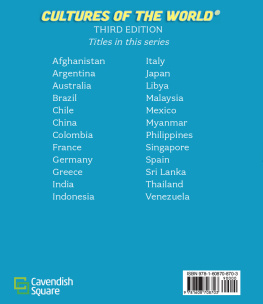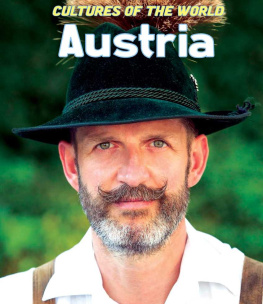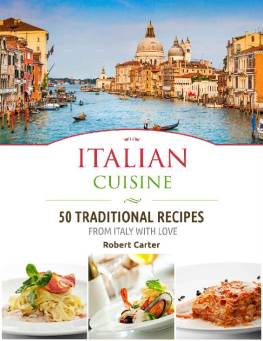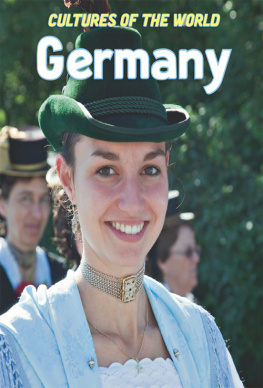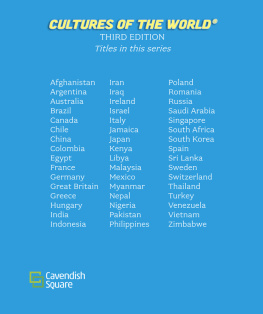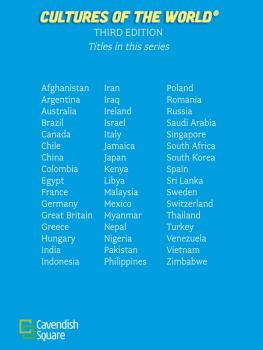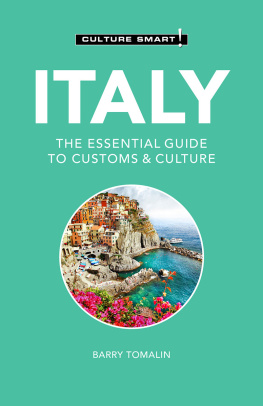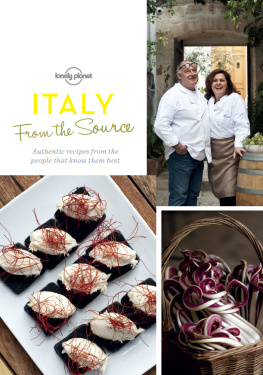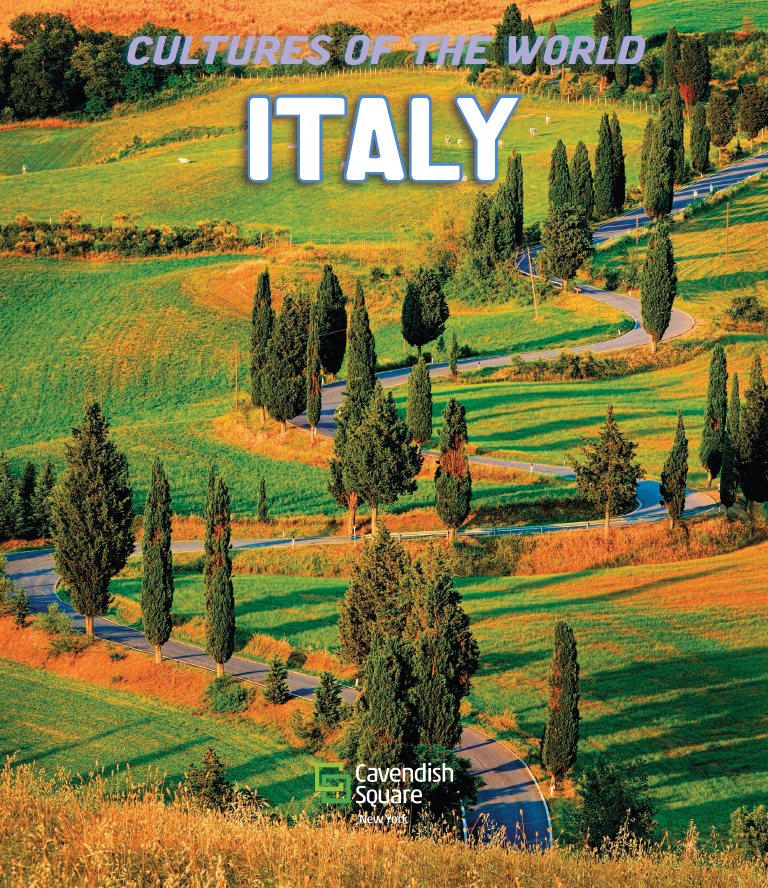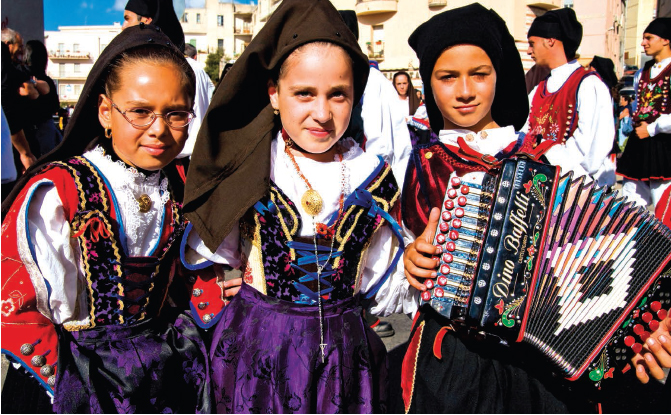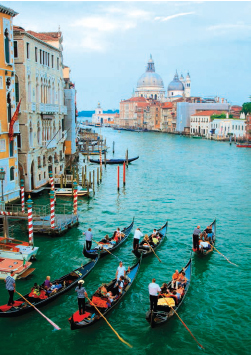Published in 2014 by Cavendish Square Publishing, LLC
303 Park Avenue South, Suite 1247, New York, NY 10010
Third Edition
This publication is published with arrangement with Marshall Cavendish International (Asia) Pte Ltd.
Copyright 2014 Marshall Cavendish International (Asia) Pte Ltd.
All rights reserved. No part of this publication may be reproduced or transmitted in any form or by any means, or stored in any retrieval system of any nature without the prior written permission of Marshall Cavendish International (Asia) Pte Ltd.
Website: cavendishsq.com
Cultures of the World is a registered trademark of Times Publishing Limited.
This publication represents the opinions and views of the author based on his or her personal experience, knowledge, and research. The information in this book serves as a general guide only. The author and publisher have used their best efforts in preparing this book and disclaim liability rising directly or indirectly from the use and application of this book.
CPSIA Compliance Information: Batch #WS13CSQ
All websites were available and accurate when this book was sent to press.
Library of Congress Cataloging-in-Publication Data
Winter, Jane Kohen, 1959
Italy / Jane Kohen Winter, Leslie Jermyn, Jo-Ann Spilling. 3rd ed.
p. cm. (Cultures of the world)
Includes bibliographical references and index.
Summary: Provides comprehensive information on the geography, history,
wildlife, governmental structure, economy, cultural diversity, peoples,
religion, and culture of MalaysiaProvided by publisher.
ISBN 978-1-60870-870-3 (print) - ISBN 978-1-60870-876-5 (ebook)
1. ItalyJuvenile literature. I. Jermyn, Leslie. II. Spilling, Jo-Ann.
III. Title IV Series.
DG417.W56 2014
945dc23 2012018492
Writers: Jane Kohen Winter, Leslie Jermyn, Jo-Ann Spilling
Editors: Deborah Grahame-Smith, Mindy Pang
Copyreader:Tara Tomczyk
Designers: Nancy Sabato, Adithi
Cover picture researcher: Tracey Engel
Picture researcher: Joshua Ang
PICTURE CREDITS
Cover: theodore liasi / Alamy
Corbis / Click Photos 28, 112 Getty Images 73 Inmagine 1, 3, 5, 6, 8, 10, 13, 14, 15, 16, 18, 20, 21, 24, 26, 27, 29, 30, 32, 33, 34, 37, 38, 40, 41, 42, 43, 44, 45, 46, 47, 48, 49, 50, 51, 52, 53, 54, 55, 56, 58, 59, 60, 61, 62, 64, 65, 67, 69, 71, 72, 74, 75, 76, 78, 79, 80, 81, 82, 83, 84, 86, 87, 88, 89, 90, 91, 93, 94, 96, 97, 99, 100, 101, 102, 103, 104, 105, 107, 108, 109, 110, 111, 114, 115, 116, 117, 118, 119, 120, 122, 123, 124, 125, 126, 127, 128, 129, 130, 131 North Wind Picture Archives 23 Wikimedia Commons 92, 95, 98
PRECEDING PAGE
A winding rural road near the picturesque town of Monticchiello in Val dOrcia, Tuscany.
Printed in the United States of America
CONTENTS
ITALY TODAY
1. GEOGRAPHY Mountains, lakes, and rivers Northern Italy Southern Italy Sicily and Sardinia Climate Plants Animal life
2. HISTORY The Etruscans and the Phoenicians The Roman republic The Roman Empire The Middle Ages The Renaissance Foreign domination Independence and unification The Italian kingdom The Fascist era The Italian republic
3. GOVERNMENT Divisions of government Local government Independent states Political parties Coalition governments Attitudes toward government
4. ECONOMY Trade and employment Agriculture Mining and energy Industry Services The Italian workday Economic problems
5. ENVIRONMENT Endangered species Air pollution Protecting natures gifts Fighting air pollution Creative solutions
6. ITALIANS Ethnic groups Migration Regionalism Class distinctions
7. LIFESTYLE Apartment living Villas Natural elegance Institutional inefficiency Importance of the family Childhood has its privileges Italian masculinity Italian femininity Education
8. RELIGION The ancient Roman gods Religion and law Roman Catholicism and Italian social life Vatican City Other religions and folk beliefs
9. LANGUAG Official and standard Italian Regional dialects The influence of Italian and vice versa Body language Titles Other languages and dialects
10. ART Art history in modern life The Renaissance The opera Literature The arts in modern Italy
11. LEISUR The passeggiata Soccer mania Baseball Basketball Other outdoor pursuits Television Movies and music The reading public
12. FESTIVAL Food and the arts The importance of festivals Carnival Palio di Siena Christmas
13. FOOD Grocery shopping Regional specialties Italian wines Meals and mealtimes Gelato Coffee
MAP OF ITALY
ABOUT THE ECONOMY
ABOUT THE CULTURE
TIMELINE
GLOSSARY
FOR FURTHER INFORMATION
BIBLIOGRAPHY
INDEX
ITALY TODAY
S INCE ANCIENT TIMES, WHEN THE ROMAN EMPIRE RULED MOST of Western Europe from its base in the city of Rome, Italy has exerted great influence in the advancement of Europe and Western civilization. Today Italy is one of the largest economies in the world and continues to play a significant role in the development of the European Union.
As a peninsula extending into the central Mediterranean Sea, Italy is easily recognized by its boot-like shape. This nation-state consists of an interesting and varied mix of geographical features. It is dominated by mountainsthe northern Dolomite mountain range and the Apennine, which extends from the north to the south, slicing through the center of the country. Just south of the Dolomites, there is the fertile agricultural land of the Po Valley. Italy is also made up of two large islandsthe mountainous Sardinia and the volcanic Sicily. Within Italy there exist two sovereign statesVatican City, where the Pope generally resides, and the oldest surviving Republic of San Marino.
Italy offers many attractions; its cultural and historical heritage is a magnet to touristsmore than 43 million visitors arrive every year from all over the globe, making it the fifth most visited country in the world. The tourism industry is a key contributor to Italys economy, generating vital revenue and providing much-needed employment opportunities for many, particularly in the service sector. Tourists come to experience Italys ancient history, famous artworks, fine cuisine, and spectacular scenery. Popular places to visit include the unique Leaning Tower of Pisa, the waterways and gondolas of Venice, the Colosseum and other ancient ruins and monuments in Rome, the splendid Ponte Vecchio in Florence, the vineyards and medieval hill towns of Tuscany, the stunning coastline along the Amalfi coast, the alpine ski resorts of the Dolomites and much more.
More than 70 percent of Italys population (of more than 61 million) live in cities and towns while the rest of the people live in rural areas. It is a well-known fact that within Italy there exists a distinct North-South divide. Northern Italy is prosperous. It enjoys a developed and industrialized economy, producing and manufacturing the best designs in clothing, textiles, footwear, furniture, cars, and electronics. The North also produces agricultural items including wheat, rice, and grain. Southern Italy is comparatively poorerits economy is less advanced, with many working on farms and growing fruits and vegetables.

